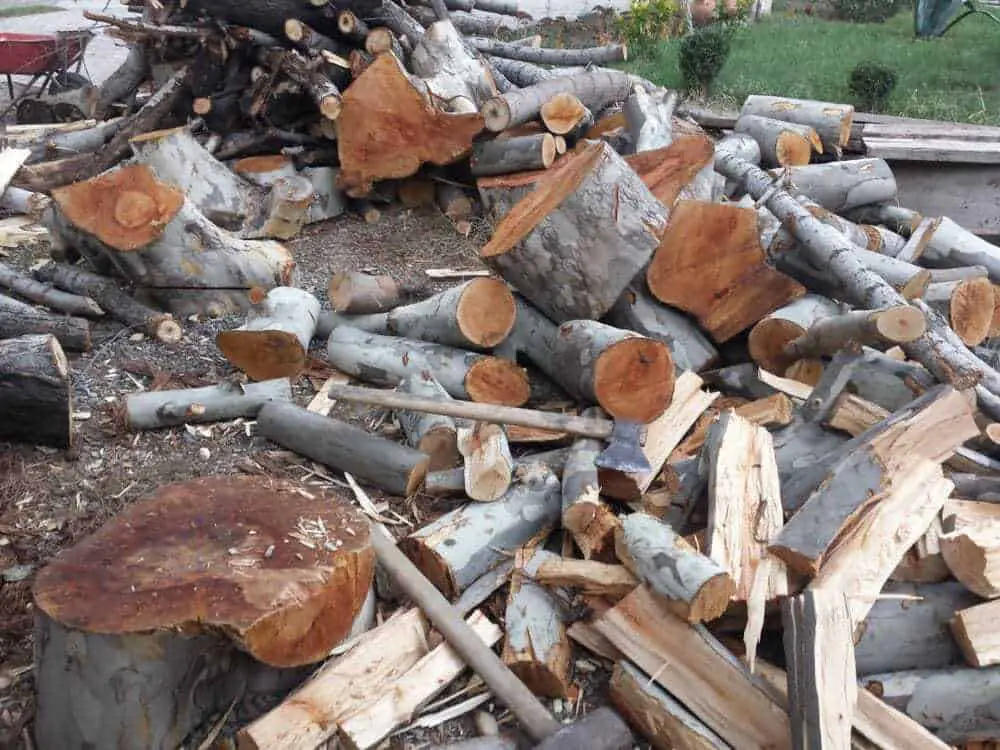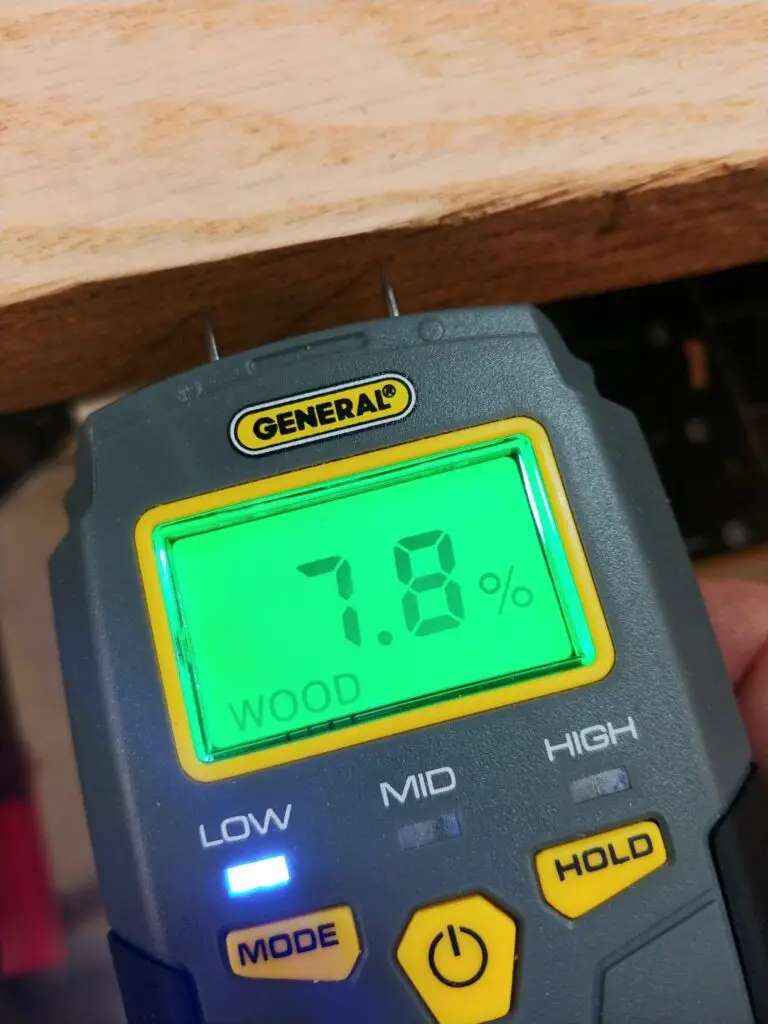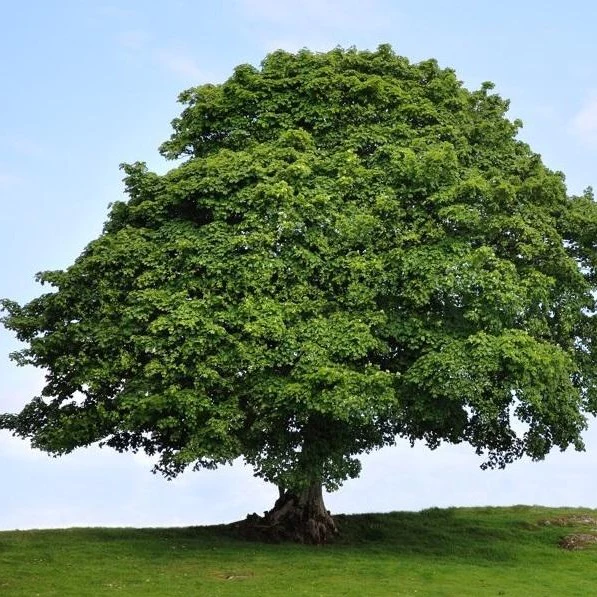Sycamore firewood is a good, low-density option that ignites easily and burns hot with minimal smoke. Ideal for indoor and outdoor use, it burns faster than denser woods. Maximize efficiency by mixing with slower-burning woods and ensure proper seasoning for optimal performance and safety.
I have compiled some of the critical specifications and insights into sycamore firewood’s performance and whether you should add it to your winter stockpile.
Table of Contents
Summary
- BTU: 20 million BTU/cord
- Weight: 5000 lb/cord green
- Seasoning Time: 12-24 months
- Splitting Difficulty: Difficult
- Sap Content: Low
- Smoke: Moderate
- Smell: Neutral
Overall, sycamore is good firewood. It has a moderate amount of heat generation slightly lower than the best firewood options. It is dense, and you can stack much wood within a cord volume storage. It has a very high moisture content when green because of its preferred location near rivers, so it can take a long time to season. It has a low sap content meaning it doesn’t pop or crackle, and you don’t need to worry about creosote.
However, it does have some disadvantages. It is one of the more difficult woods to split, especially when green, because its stringy fibers make it difficult to separate logs. It can also produce a moderate amount of smoke, especially if you are tempted to burn it before it is completely dry.

Heat Production
Sycamore firewood only has a medium heat production of 20 million BTU/cord. This is around 25% lower than the top-class woods of oak and ash. If you are using this as your principal wood for winter, then consider this when planning how many cords you need.
It is still slow burning and will develop excellent coals that are good for cooking. Sycamore is still a hardwood and can be challenging to light initially, so it is worth preparing some softwood kindling from pine to help start the fire.
Smoke Production
Sycamore can produce a moderate amount of smoke, but in my experience, this is primarily because people haven’t waited long enough for the green wood to dry thoroughly. I will detail this in the next section, but sycamore has a higher moisture concentration and can take a very long time to season fully. I always recommend being patient and never burning unseasoned wood. This will reduce the smoke generation and increase the heat production of each log.
Seasoning Time
Sycamore wood has a much higher moisture content than other hardwoods because the trees are most likely found next to water sources, like rivers or streams. This means that they do take longer to season. I have seen anywhere from 12 to 24 months to get the moisture content below 20%. The wood is very dense, and it can feel like it takes forever to get all the moisture out of it.
The best way to reduce the seasoning time is through a good design of your firewood stack. Stack your wood in rows to increase the airflow as much as possible. It is also good to cover the top of the pile from the rain while leaving the sides open for sunshine and wind. Your location and environment plays a significant role in determining the seasoning time for any wood, but especially for slow-drying species like sycamore.
I personally recommend this General Tools Moisture Meter. It allows you to accurately gauge how wet your firewood is and whether it is sufficiently seasoned. Over time you can also see how quickly the moisture is dropping and how much longer you need to keep your firewood dropping until it is seasoned and ready to burn.
Press the sharp pins into the wood and you will quickly see the readout show the moisture ranging from 5% to 50%. It also has a Low/Mid/High indication depending on whether the wood is dry enough, so you don’t need to remember the actual values.

Burning Smell
Sycamore doesn’t have a strong smoke smell. It certainly doesn’t have the famous aroma of hickory or cherry, but it doesn’t have a bad smell either. Sycamore is ideal for people who are sensitive to odors and don’t want to smoke out their homes. Although it does have a moderate amount of smoke generation (especially if it is still wet), this smoke doesn’t carry a strong smell.
Creosote Buildup
Creosote is a black soot that can build up in your chimney from unburnt wood. It is particularly relevant in high sap wood, like unseasoned softwood. Pine is awful for creosote production. Over time this can develop into a risk of fires starting in your chimney and should be avoided whenever possible.
Sycamore has a low sap content, and as long as it is adequately seasoned to below 20% moisture, it doesn’t generate much creosote.
I still recommend chimney cleaning regularly, regardless of wood type, to eliminate this risk as much as possible.
Splitting
Sycamore is renowned for being difficult to split. This is because of its higher moisture content when green. The fibers are very stringy, which makes it challenging to separate entirely. I recommend getting a powered log splitter to help process these large trees. You get a high firewood yield per tree, so it is worth getting the additional tools to help the job get done faster.
Different Types/Species
In this section, I have explored the three most common species – the American, Californian, and Mexican sycamore. There are other varieties that I haven’t gone into detail, such as the Old World, Arizona, and English sycamore.
American Sycamore
Also known as buttonwood and western plane trees, American sycamores grow in the eastern United States. They are typically found near rivers and are used as shade trees in urban areas.
- Heat Production: 19.1 million BTU/cord
- Height: 100-130 feet
Californian Sycamore
Californian sycamore is also called western sycamore or California plane trees. They are found along the west coast of the US and are very drought resistant.
- Heat Production: 19.5 million BTU/cord
- Height: 80-110 feet
Mexican Sycamore
Mexican sycamores are smaller than their American cousins but are much more fast-growing. They tolerate heat well and around found throughout the western United States.
- Heat Production: 19.1 million BTU/cord
- Height: 40-50 feet

Comparison to Other Woods
Here, I’ve taken some of the most popular firewoods to burn indoors and compared them to sycamore firewood.
Sycamore doesn’t belong in the top-tier firewood category like oak or maple. It has a lower heat production, so you need to stockpile an additional 25% and add logs more frequently. It still does produce high-quality coals that can be used for cooking, but I have found it is tough to split.
| Firewood | Million BTU/Cord (source) | Ease of Splitting | Coals | Overall Quality |
| Green Ash | 20 | Easy | Good | Excellent |
| Maple | 25 | Easy | Excellent | Excellent |
| Bur Oak | 26 | Easy | Good | Excellent |
| Sycamore | 20 | Difficult | Good | Good |
Overall, I classify sycamore as good firewood without being excellent.
FAQs
Can you burn sycamore wood in a fire pit?
Yes, sycamore is ideal for burning outdoors. It generates good coals that are well suited for cooking that produce a stable temperature profile. You may need to add more logs than with higher heat production firewood. It also does generate a moderate amount of smoke, but the smell isn’t strong, and you won’t overpower your campsite.
Can you burn sycamore wood in a wood stove?
Yes, sycamore is a good option for heating your home in winter. It does produce a moderate amount of smoke if it hasn’t been fully dried, so make sure you give it enough time to season correctly. It also has a lower heat production than oak or hickory, so make sure you process more than you would otherwise to last all winter.
How much does sycamore firewood cost to buy?
Sycamore costs less than higher-quality hardwoods, like oak or ash, and can be purchased for between $250 and $350 per cord. Remember that you will need to buy an additional 25% of sycamore to produce the same amount of heat because of its lower BTU.
Final Thoughts
Sycamore is good firewood with moderate heat production and low sap content. I have never found it to pop or crackle from resin pockets igniting. It can be difficult to split and because the trees are so large, I always use a hydraulic log splitter to process the logs more quickly. It can also take a very long time for the high moisture wood to dry, so make sure you split it into small pieces and stack it with enough surface area to season as fast as possible. This also means you will need to play your firewood needs out multiple years in advance.
